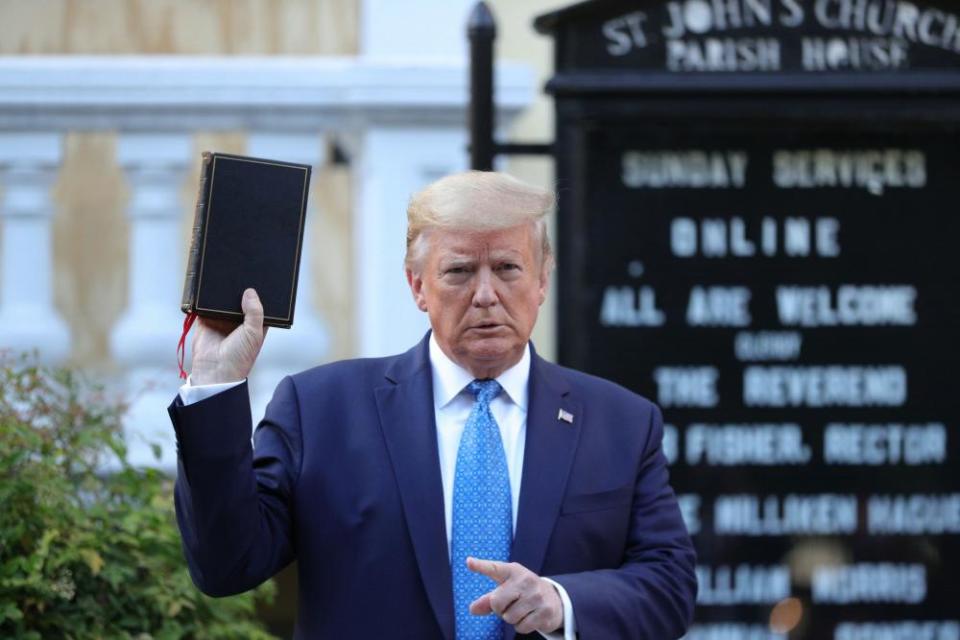'How did we get here?': Trump has normalised mayhem and the US is paying the price

The sheer tumult of the Trump era, the unceasing torrent of events that were unthinkable even hours before, has left a nation constantly off balance, unable to find its bearing and grasp how far it has traveled.
The developments of the past 24 hours were a reminder of how slippery the downward slope has been.
More than a hundred thousand Americans are dead from a pandemic after the government’s botched response; there are armoured cars and troops outside Washington metro stations; men in combat gear carrying sniper rifles were seen perched in the open door of a helicopter flying low over the commercial district. A military chopper buzzed a crowd of demonstrators so close to the ground they were buffeted around by the wind from the rotor, a dispersal technique learned in counter-insurgencies abroad.
On Monday, an entirely peaceful protest was driven out of a city square in front of the White House with teargas, baton charges and mounted police, so Trump could pose in front of a church with a Bible.
A priest and a seminarian, who had been distributing water and hand sanitizer to protesters from the steps of St John’s Episcopal, were driven away by police with helmets and riot shields to create an uncluttered tableau. A Bible was procured for Trump from inside the church for him to hold aloft. Journalists asked if it was his Bible. “It’s a Bible,” he replied.
The rate of fresh affronts has often outpaced the capacity to digest – or even describe – them. Peaceful protesters, journalists, a young African American man pleading for mutual understanding, shop owners, residents are being targeted for arbitrary arrest or police beatings or both – especially if they are black.
Overnight the very language of governance has changed. The defence secretary has described US cities as the “battlespace” and the president has rejoiced in his administration’s “overwhelming force” and “domination” over the citizenry.
As each extraordinary moment slides by it poses its own question – “How did we get here?” – but then is swept away by the relentless flow of the Twitter feed. Simply trying to take stock is exhausting.
One reason it is so hard to keep track of the descent is the near instant normalisation of every bizarre new turn, administered like a fast-acting anaesthetic. Trump is surrounded by more coherent people insisting nothing out of the ordinary is happening. Anyone unable to restrain themselves from yelling “this is crazy” left the administration some time ago. In William Barr, Trump has an attorney general ready to draft executive orders at will, together with legal-sounding justifications.

Among the gang of officials walking behind Trump for his Bible photo op was the defence secretary, Mark Esper, and the country’s top general, the chairman of the joint chiefs of staff, Mark Milley, wearing combat fatigues. Their presence on Lafayette Square, walking amid the detritus left by fleeing protesters, stepped over the line that is supposed to separate the US military from domestic politics and added ballast to Trump’s imagery of a righteous war against a pernicious enemy within.
The Pentagon later said the two men had no idea where they were being led when they fell in line behind the president in the grounds of the White House, and had no clue about the means used to clear Lafayette Square before their arrival. But the washing of hands was performed by an unnamed defence official. Neither Esper nor Milley renounced their actions on camera.
It is not just the public officials. The constitutional constraints have also shown themselves more elastic than previously thought. Congress can demand to see officials and documents it needs to perform its duty of oversight but the administration now feels empowered to ignore such calls whenever it wants and suffer no consequences.
Related: George Floyd protests: can Trump deploy federal troops on to the streets in the US?
The 1807 Insurrection Act, which Trump is dangling over the nation, seems amorphous enough to allow the president to deploy the armed forces against the wishes of the states, if he deems circumstances to have made it “impracticable to enforce” the law.
Fear is easing the way for each new step towards militarisation. The looting and destruction on the fringes of the protests are terrifying, but partly a consequence of law enforcement tactics. The police have focused on dispersing the protests rather on arresting the looters. And it is the violence that plays on a loop on the news.
The other reason it is so hard to keep track of the downward slide is the daily farce of the Donald Trump show. On Tuesday, at a Catholic shrine (day two of a brief detour into Christianity), it was the president telling his wife out of the side of his mouth to smile and her half-hearted attempt to obey.
The day before, it was the long amble from the White House to St John’s, with the president walking 20 yards in front of his cabinet and relatives – with his odd straight-armed, chest-out gait and his trousers, a couple of inches short, flapping around his ankles – past the “Fuck Trump” graffiti on the public toilets.
Related: A photo op as protests swirled: how Trump came to walk to the church
And then, on reaching the church, holding the Bible at various angles, including upside down, like an unfamiliar device pulled at random from a toolbox, which it was. He had once claimed it was his favourite book but when asked which was his favourite verse, he became flustered and dodged, insisting “the whole Bible is incredible”.
One of the lessons of history is beware the buffoon, but when every day is so bizarre and distracting those lessons are hard to remember. We are constantly negotiating the rapids. And each day brings us closer to forgetting what normal used to look like.

 Yahoo News
Yahoo News 
